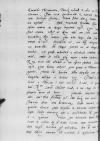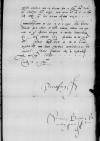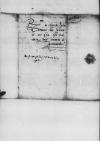Nactus hanc mittendi istuc occasionem, facere nolui, quin meas ad Reverendissimam Dominationem Vestram darem, quibus cum Reverendissimam Dominationem Vestram pro mea perpetua observantia salutarem, tum significarem illi eius me accepisse litteras, humanitatis et non ignotae mihi illius erga me benevolentiae plenas, de quibus, simul et de epigrammatis apologeticis mihi missis, magnas Reverendissimae Dominationi Vestrae habeo gratias, quamquam iam antea Samuel Maciejowski (*1499 – †1550), humanist and diplomat, one of the most trusted advisors to King Sigismund I and then to his son Sigismund II Augustus; from 1521 Canon of the Collegiate Chapter in Sandomierz, and from 1530 in Kielce; from 1531 Canon of Gniezno; from 1532 or 1533 to 1537 royal secretary (previously scribe at the royal chancellery); 1537-1539 Grand Secretary; 1539-1547 Crown Vice-Chancellor; 1539-1541 Bishop of Chełm; 1541-1545 Bishop of Płock; 1545-1550 Bishop of Cracow; 1547-1550 Crown Grand Chancellor; in 1532 royal envoy to Rome; in 1534 and 1538 royal envoy to the local diets (WYCZAŃSKI 1990, p. 257-258; Urzędnicy 10, p. 184; PSB 19 Machowski - Maria Kazimiera, p. 64-69)⌊dominus reverendissimus meus ChelmensisSamuel Maciejowski (*1499 – †1550), humanist and diplomat, one of the most trusted advisors to King Sigismund I and then to his son Sigismund II Augustus; from 1521 Canon of the Collegiate Chapter in Sandomierz, and from 1530 in Kielce; from 1531 Canon of Gniezno; from 1532 or 1533 to 1537 royal secretary (previously scribe at the royal chancellery); 1537-1539 Grand Secretary; 1539-1547 Crown Vice-Chancellor; 1539-1541 Bishop of Chełm; 1541-1545 Bishop of Płock; 1545-1550 Bishop of Cracow; 1547-1550 Crown Grand Chancellor; in 1532 royal envoy to Rome; in 1534 and 1538 royal envoy to the local diets (WYCZAŃSKI 1990, p. 257-258; Urzędnicy 10, p. 184; PSB 19 Machowski - Maria Kazimiera, p. 64-69)⌋ eadem mihi miserat, quod fortasse ea ex Reverendissima Dominatione Vestra habuerat. Sed tamen ab ipsa Reverendissima Dominatione Vestra illa habuisse pergratum mihi fuit.
Facerem equidem pro mea consuetudine non solum libenter, verum etiam pluribus verbis diligenter, ut, si quid novi hic esset, perscribere id Reverendissimae Dominationi Vestrae non negligerem. Verum est nunc quidem in hoc genere nihil, quod a me illi scribi oportere, magnopere existimarem. Nam quid in Lithuania⌊LituaniaLithuania⌋ rerum geratur, id non ego hic melius, quam Reverendissima Dominatio Vestra istic cotidie noscere potest.
Sed nec illud iam ignorat serenissimum
Ung(arorum) or Ungar(iae)⌈Ung(arorum)Ung(arorum) or Ungar(iae)⌉
John Zápolya (János Szapolyai) (*1487 – †1540), 1526-1540 King of Hungary; son of István Szapolyai and Jadwiga of Cieszyn in 1540 married Isabella, dauther of of King Sigismund Jagiellon of Poland. He fought against Ferdinand of Habsburg for the right to the title of King of Hungary⌊regem IohannemJohn Zápolya (János Szapolyai) (*1487 – †1540), 1526-1540 King of Hungary; son of István Szapolyai and Jadwiga of Cieszyn in 1540 married Isabella, dauther of of King Sigismund Jagiellon of Poland. He fought against Ferdinand of Habsburg for the right to the title of King of Hungary⌋ diem suum obiisse. Sepultum tamen corpus adhuc non est, Isabella Jagiellon (*1519 – †1559), 1539-1559 Queen of Hungary; from 1539 wife of John Zápolya, King of Hungary, mother of John II Sigismund Zápolya; daughter of Sigismund Jagiellon, King of Poland, and Bona Sforza⌊reginaIsabella Jagiellon (*1519 – †1559), 1539-1559 Queen of Hungary; from 1539 wife of John Zápolya, King of Hungary, mother of John II Sigismund Zápolya; daughter of Sigismund Jagiellon, King of Poland, and Bona Sforza⌋ Buda (Ofen), city in Hungary, on the right bank of the Danube river, which divides Buda from Pest, capital of the Kingdom of Hungary; in 1873 Buda, Pest and Óbuda were unified to become Budapest⌊BudaeBuda (Ofen), city in Hungary, on the right bank of the Danube river, which divides Buda from Pest, capital of the Kingdom of Hungary; in 1873 Buda, Pest and Óbuda were unified to become Budapest⌋ puerperii legitimos dies agit, sed nec filius baptizatus, nec ipsa adhuc lustrata est. Res publica interea dissidet. Pars enim auctoribus  BCz, 1597, p. 1112 monacho thesaurario, Bálint Török of Enying (Valentinus Thureck, Valent Turek) (*1502 – †1550), Hungarian noble, military commander, Ban of Belgrade, 1527-1542 Lord of Csesznek (EFE 36, p. 226 (index))⌊Tureck ValenttBálint Török of Enying (Valentinus Thureck, Valent Turek) (*1502 – †1550), Hungarian noble, military commander, Ban of Belgrade, 1527-1542 Lord of Csesznek (EFE 36, p. 226 (index))⌋ et aliis in Transylvania, region in the central part of Romania, bounded on the east and south by the Carpathian mountain range. Historical Transylvania extended in the west to the Apuseni Mountains⌊TransilvaniaTransylvania, region in the central part of Romania, bounded on the east and south by the Carpathian mountain range. Historical Transylvania extended in the west to the Apuseni Mountains⌋, pars circa Košice (Cassovia, Kassa), town in Kingdom of Hungary, Upper Hungary, today in Slovakia⌊CaschoviamKošice (Cassovia, Kassa), town in Kingdom of Hungary, Upper Hungary, today in Slovakia⌋ et Eger (Agria), city in northern Hungary, the county seat of Heves, east of the Mátra Mountains⌊AgriamEger (Agria), city in northern Hungary, the county seat of Heves, east of the Mátra Mountains⌋ Monacho, item archiepiscopo Colocensi Perenni Petro aliisque ducibus comi hidden by binding⌈[i]i hidden by binding⌉tia agitant. Apud reginam Nicolaus comes de Salmis nomine sui regis legatum egit, cuius legationis fuit summa, vellet ne illius maiestas cum filio pactis condicionibusque illis manere, quibus inter reges olim fuit conventum, an non. Responsum est suae maiestati integrum non esse inconsultis maiestate regia parente suo ac Regni primoribus, sine quorum auctoritate et voluntate factura sit nihil, tantis de rebus quic ms. t(!)
⌈cc ms. t(!)
⌉quam agere, nedum statuere. Rex visus sibi abunde se suo officio functum exercitum cogit, quem Buda (Ofen), city in Hungary, on the right bank of the Danube river, which divides Buda from Pest, capital of the Kingdom of Hungary; in 1873 Buda, Pest and Óbuda were unified to become Budapest⌊BudamBuda (Ofen), city in Hungary, on the right bank of the Danube river, which divides Buda from Pest, capital of the Kingdom of Hungary; in 1873 Buda, Pest and Óbuda were unified to become Budapest⌋ mitteret, prius quam a The Ottoman Turks (Turcae) ⌊ThurcisThe Ottoman Turks (Turcae) ⌋ occuparetur. Ferunt enim Bascha Székesfehérvár (Alba Regalis, Białogród Stołeczny, Stuhlweißenburg), city in central Hungary⌊Albae RegalisSzékesfehérvár (Alba Regalis, Białogród Stołeczny, Stuhlweißenburg), city in central Hungary⌋ cum quadraginta milibus eo tendere etc. Tametsi non desunt, qui Suleiman the Magnificent (*1494 – †1566), 1520-1566 Sultan of the Ottoman Empire⌊ThurcamSuleiman the Magnificent (*1494 – †1566), 1520-1566 Sultan of the Ottoman Empire⌋ e vivis excesisse dicant, ad quem dominus magnificus Hieronim Łaski (Jarosław Łaski, Hieronymus de Lasco) (*1496 – †1541), diplomat in the service of Sigismund I Jagiellon and John I Zápolya, representing them in diplomatic contacts with Ferdinand I of Habsburg and Sultan Suleiman I; 1520-1522 Crown Carver, 1522-1523 Voivode of Inowrocław, 1523-1541 Voivode of Sieradz, from 1528 Zupan of the Spiš district; from 1530 Voivode of Transylvania (PSB 18, p. 225-229)⌊LasskiHieronim Łaski (Jarosław Łaski, Hieronymus de Lasco) (*1496 – †1541), diplomat in the service of Sigismund I Jagiellon and John I Zápolya, representing them in diplomatic contacts with Ferdinand I of Habsburg and Sultan Suleiman I; 1520-1522 Crown Carver, 1522-1523 Voivode of Inowrocław, 1523-1541 Voivode of Sieradz, from 1528 Zupan of the Spiš district; from 1530 Voivode of Transylvania (PSB 18, p. 225-229)⌋ palatinus Siradiensis a suo rege die 25 Augusti missus est etc.
BCz, 1597, p. 1112 monacho thesaurario, Bálint Török of Enying (Valentinus Thureck, Valent Turek) (*1502 – †1550), Hungarian noble, military commander, Ban of Belgrade, 1527-1542 Lord of Csesznek (EFE 36, p. 226 (index))⌊Tureck ValenttBálint Török of Enying (Valentinus Thureck, Valent Turek) (*1502 – †1550), Hungarian noble, military commander, Ban of Belgrade, 1527-1542 Lord of Csesznek (EFE 36, p. 226 (index))⌋ et aliis in Transylvania, region in the central part of Romania, bounded on the east and south by the Carpathian mountain range. Historical Transylvania extended in the west to the Apuseni Mountains⌊TransilvaniaTransylvania, region in the central part of Romania, bounded on the east and south by the Carpathian mountain range. Historical Transylvania extended in the west to the Apuseni Mountains⌋, pars circa Košice (Cassovia, Kassa), town in Kingdom of Hungary, Upper Hungary, today in Slovakia⌊CaschoviamKošice (Cassovia, Kassa), town in Kingdom of Hungary, Upper Hungary, today in Slovakia⌋ et Eger (Agria), city in northern Hungary, the county seat of Heves, east of the Mátra Mountains⌊AgriamEger (Agria), city in northern Hungary, the county seat of Heves, east of the Mátra Mountains⌋ Monacho, item archiepiscopo Colocensi Perenni Petro aliisque ducibus comi hidden by binding⌈[i]i hidden by binding⌉tia agitant. Apud reginam Nicolaus comes de Salmis nomine sui regis legatum egit, cuius legationis fuit summa, vellet ne illius maiestas cum filio pactis condicionibusque illis manere, quibus inter reges olim fuit conventum, an non. Responsum est suae maiestati integrum non esse inconsultis maiestate regia parente suo ac Regni primoribus, sine quorum auctoritate et voluntate factura sit nihil, tantis de rebus quic ms. t(!)
⌈cc ms. t(!)
⌉quam agere, nedum statuere. Rex visus sibi abunde se suo officio functum exercitum cogit, quem Buda (Ofen), city in Hungary, on the right bank of the Danube river, which divides Buda from Pest, capital of the Kingdom of Hungary; in 1873 Buda, Pest and Óbuda were unified to become Budapest⌊BudamBuda (Ofen), city in Hungary, on the right bank of the Danube river, which divides Buda from Pest, capital of the Kingdom of Hungary; in 1873 Buda, Pest and Óbuda were unified to become Budapest⌋ mitteret, prius quam a The Ottoman Turks (Turcae) ⌊ThurcisThe Ottoman Turks (Turcae) ⌋ occuparetur. Ferunt enim Bascha Székesfehérvár (Alba Regalis, Białogród Stołeczny, Stuhlweißenburg), city in central Hungary⌊Albae RegalisSzékesfehérvár (Alba Regalis, Białogród Stołeczny, Stuhlweißenburg), city in central Hungary⌋ cum quadraginta milibus eo tendere etc. Tametsi non desunt, qui Suleiman the Magnificent (*1494 – †1566), 1520-1566 Sultan of the Ottoman Empire⌊ThurcamSuleiman the Magnificent (*1494 – †1566), 1520-1566 Sultan of the Ottoman Empire⌋ e vivis excesisse dicant, ad quem dominus magnificus Hieronim Łaski (Jarosław Łaski, Hieronymus de Lasco) (*1496 – †1541), diplomat in the service of Sigismund I Jagiellon and John I Zápolya, representing them in diplomatic contacts with Ferdinand I of Habsburg and Sultan Suleiman I; 1520-1522 Crown Carver, 1522-1523 Voivode of Inowrocław, 1523-1541 Voivode of Sieradz, from 1528 Zupan of the Spiš district; from 1530 Voivode of Transylvania (PSB 18, p. 225-229)⌊LasskiHieronim Łaski (Jarosław Łaski, Hieronymus de Lasco) (*1496 – †1541), diplomat in the service of Sigismund I Jagiellon and John I Zápolya, representing them in diplomatic contacts with Ferdinand I of Habsburg and Sultan Suleiman I; 1520-1522 Crown Carver, 1522-1523 Voivode of Inowrocław, 1523-1541 Voivode of Sieradz, from 1528 Zupan of the Spiš district; from 1530 Voivode of Transylvania (PSB 18, p. 225-229)⌋ palatinus Siradiensis a suo rege die 25 Augusti missus est etc.
Conventus Haguenau (Hagenau), town in Alsace, north of Strasbourg (today in northeastern France, Bas-Rhin département)⌊HagenoaeHaguenau (Hagenau), town in Alsace, north of Strasbourg (today in northeastern France, Bas-Rhin département)⌋ nuper actus, quo fini dissolutus sit, iam hoc quoque non nescit. Principes Germaniae: dux Brunsvicensis, elector Saxoniae, Landtgravius Hessiae, quam turpibus et vilissimo cerdone vix dignis libellis conviciisque inter se conflictentur, non puto Reverendissimam Dominationem Vestram ignorare.
Charles V of Habsburg (*1500 – †1558), ruler of the Burgundian territories (1506-1555), King of Spain as Charles I (1516-1556), King of Naples and Sicily, King of the Romans (1519-1530), Holy Roman Emperor of the German Nation (elected 1519, crowned 1530, abdicated 1556); son of Philip I the Handsome and Joanna the Mad of Castile⌊CaesarCharles V of Habsburg (*1500 – †1558), ruler of the Burgundian territories (1506-1555), King of Spain as Charles I (1516-1556), King of Naples and Sicily, King of the Romans (1519-1530), Holy Roman Emperor of the German Nation (elected 1519, crowned 1530, abdicated 1556); son of Philip I the Handsome and Joanna the Mad of Castile⌋ per inferiorem Germaniam, Flanders (Flandria), county in the Low Countries, part of the Habsburg Netherlands from 1482, today corresponding to the Belgian provinces of Western Flanders and Eastern Flanders, the region of Zeeuws-Vlaanderen in the Netherlands and part of the Département du Nord in France⌊FlandriamFlanders (Flandria), county in the Low Countries, part of the Habsburg Netherlands from 1482, today corresponding to the Belgian provinces of Western Flanders and Eastern Flanders, the region of Zeeuws-Vlaanderen in the Netherlands and part of the Département du Nord in France⌋ et ceteras illo in tractu diciones suas decurrens tributa exigit, incertum, quid moliatur. Bene tamen iam ei cum Francis I of Valois (*1494 – †1547), 1515-1547 King of France; son of Charles, Count of Angoulême, and Louise of Savoy⌊rege GalliaeFrancis I of Valois (*1494 – †1547), 1515-1547 King of France; son of Charles, Count of Angoulême, and Louise of Savoy⌋ convenire et excitatos de Mediolano tumultus hidden by binding⌈[tus]tus hidden by binding⌉  BCz, 1597, p. 1113 pulchre considisse cum ex aliorum, tum ex reverendissimi domini Johan Weze (*1490 – †1548), secretary to King Christian II of Denmark; in 1522 nominated Archbishop of Lund; in 1527 was banished from Denmark as Christian II's secretary, and joined the service of Emperor Charles V as his diplomat, 1537-1548 Bishop of Constance (WHALEY, p. 314)⌊archiepiscopi LundensisJohan Weze (*1490 – †1548), secretary to King Christian II of Denmark; in 1522 nominated Archbishop of Lund; in 1527 was banished from Denmark as Christian II's secretary, and joined the service of Emperor Charles V as his diplomat, 1537-1548 Bishop of Constance (WHALEY, p. 314)⌋ litteris accepi, cuius ipsius ad Reverendissimam Dominationem Vestram litteras eidem mitto, quas heri Vienna (Wien, Vienna), city in eastern Austria, on the Danube river⌊ViennaVienna (Wien, Vienna), city in eastern Austria, on the Danube river⌋ allatas accepi.
BCz, 1597, p. 1113 pulchre considisse cum ex aliorum, tum ex reverendissimi domini Johan Weze (*1490 – †1548), secretary to King Christian II of Denmark; in 1522 nominated Archbishop of Lund; in 1527 was banished from Denmark as Christian II's secretary, and joined the service of Emperor Charles V as his diplomat, 1537-1548 Bishop of Constance (WHALEY, p. 314)⌊archiepiscopi LundensisJohan Weze (*1490 – †1548), secretary to King Christian II of Denmark; in 1522 nominated Archbishop of Lund; in 1527 was banished from Denmark as Christian II's secretary, and joined the service of Emperor Charles V as his diplomat, 1537-1548 Bishop of Constance (WHALEY, p. 314)⌋ litteris accepi, cuius ipsius ad Reverendissimam Dominationem Vestram litteras eidem mitto, quas heri Vienna (Wien, Vienna), city in eastern Austria, on the Danube river⌊ViennaVienna (Wien, Vienna), city in eastern Austria, on the Danube river⌋ allatas accepi.
Commendatissimum me esse Reverendissimae Dominationi Vestrae cupio, cuius benevolentiam quia facio, ut debeo, maximi, daturus sum operam, ne quid officiosi obsequii in tuenda demerendaque illa cuiquam faciam reliqui, quantum in me certe erit. Precor Dominum Deum, ut Reverendissimam Dominationem Vestram sospitem et omni bona fortuna cumulatissimam diu conservet.
 BCz, 1597, p. 1112 monacho thesaurario,
BCz, 1597, p. 1112 monacho thesaurario,  BCz, 1597, p. 1113 pulchre considisse cum ex aliorum, tum ex reverendissimi domini
BCz, 1597, p. 1113 pulchre considisse cum ex aliorum, tum ex reverendissimi domini 


